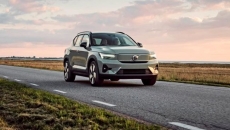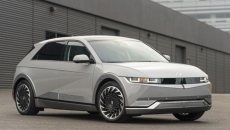While fully automated vehicles are still a ways off, the stepping stone of hands-free driving technology has become prevalent in the past few years. These assist systems allow drivers to take their hands off the steering wheel in certain situations. Combined with automated braking and acceleration, the feature can help make driving long distances or in congested traffic easier and less fatiguing. To better explain what’s available, the automotive experts at Edmunds put four hands-free drive systems to the test: Ford’s BlueCruise, General Motors’ Super Cruise, Tesla’s AutoPilot with Full Self-Driving Beta and BMW’s Driving Assistant Plus.
FORD BLUECRUISE
Ford calls its hands-free driving system BlueCruise and offers it on a handful of its vehicles. BlueCruise allows for hands-free driving on most U.S. highways that don’t have traffic signals or intersections. Edmunds tested it on the electric Mustang Mach-E fitted with the latest version called BlueCruise 1.3.
BlueCruise is easy to turn on and use. It also worked pretty well during testing for keeping the Mach-E in its lane and keeping the proper distance from vehicles ahead. Edmunds did notice that the automatic lane change feature — the vehicle will steer itself into the next lane if you activate the turn signal — brought about a few concerning incidents in which the Mach-E was traveling a lot quicker than the vehicle in the next lane. Additionally, BlueCruise doesn’t do as good of a job as the other systems of indicating when it deactivates because of road conditions and needs the driver to take over.
GENERAL MOTORS SUPER CRUISE
Similar to BlueCruise, Super Cruise relies on an array of sensors and onboard navigation to provide hands-free driving on most mapped, divided highways. No matter where it is you call home, Super Cruise will likely be a convenient means of reducing fatigue during highway drives. Edmunds tested it on a Cadillac CT5-V sedan.
In contrast to BlueCruise, Super Cruise does a good job of indicating when it is activated and notifying the driver when it’s time to take back control of the vehicle. It also works well in most traffic situations, letting the driver relax. One negative issue did arise, however. Its automatic lane change feature was problematic at times. Occasionally the vehicle would stop halfway through a lane change and dart back to its original lane of travel. Thankfully, this mode can be turned off.
BMW HIGHWAY ASSISTANT
BMW’s Driving Assistant Plus with Highway Assistant is the company’s newest hands-free driving system. It’s a step up from earlier iterations and can work at speeds up to 80 mph on most mapped, divided highways. Edmunds tested it on the new i7 electric luxury sedan.
The i7 performed admirably for lane centering and applying smooth braking and acceleration. Its automatic lane-changing feature also generally worked better than those from BlueCruise and Super Cruise. If you’re someone who likes to dart into any available gap in traffic, however, the calmer approach taken by Highway Assistant might not be for you. At times, you might feel like you’re holding up traffic with the system engaged.
TESLA AUTOPILOT WITH FULL SELF-DRIVING BETA
Tesla Motors’ AutoPilot has come in for criticism that its name implies more than what it delivers. But the latest Full Self-Driving Beta feature gets closer to the future long promised by Tesla. Edmunds tested it on a Model Y SUV.
Ironically, AutoPilot Full Self-Driving Beta is the only one of these four systems that requires the driver to keep his or her hands on the steering wheel. In that sense, it’s not really a hands-free system yet. But AutoPilot Full Self-Driving Beta shone in other areas. It steers, accelerates and brakes correctly in highway traffic and will also make automatic lane changes without the driver’s input. Additionally, it is the only system of the four tested that will operate on city streets. To Tesla’s credit, the system recognized stop signs and traffic lights. But progress was often awkward and more than a little hair-raising. Another downside is cost: Ordering the Full Self-Driving system on a new Model Y, for example, will cost you a staggering $12,000.
EDMUNDS SAYS
Hands-free driving is here and improving with every new software development. All of these systems can be helpful. But of the four, Edmunds found GM’s Super Cruise to be the most appealing because of its informative interface and confidence-inspiring operation. And no matter what system you get, it’s important to remember that hands-free driving doesn’t mean brain-free driving.
_______






